
Each lesson below was written by an elementary teacher from the Los Angeles area. Developed through the Getty Education Department's one-year professional-development program, Art & Language Arts, these lessons were designed to meet California content standards for English–language arts and visual arts.
For more information about the program, please e-mail teacherprograms@getty.edu.
|
 |
|
 |
 |
Lessons 1–10 of 41 |
 |
 |
 |
 |
 |

  |
 |
A Natural Balance in Photography and Poetry
Grades/Level: Lower Elementary (K–2)
Subjects: Visual Arts, English—Language Arts
Lesson Overview: Students will brainstorm a list of adjectives to describe two early photographs called "cyanotypes." Next they will create their own cyanotype photograph. Students will then write original poetry using the previous list of adjectives to describe their own nature-inspired cyanotype photograph.
|
 |
 |
 |
I Spy Irises
Grades/Level: Lower Elementary (K–2)
Subjects: Visual Arts, English—Language Arts
Lesson Overview: Note: This lesson was designed for students with autism.
The students will review a few elements of art, specifically colors, shapes, and different types of lines. They will identify these elements in Vincent van Gogh's painting Irises. The students will then practice drawing different types of lines and shapes in different colors, and will use these elements of art to produce an original crayon-resist piece inspired by Irises.
|
 |
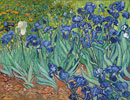 |
 |
All I Want to Do Is Dance, Dance, Dance!
Grades/Level: Upper Elementary (3–5)
Subjects: Visual Arts, English—Language Arts
Lesson Overview: Students will observe dance movements depicted in a drawing and a painting. Partners will use simple lines to draw their partner's movements and paint dance costumes on the figures using various brushstrokes. Students will write a persuasive speech to the school superintendent explaining why they believe dance should be a regular part of the curriculum. They will then model dance movements for classmates in teams of four and recite their persuasive speech to the class.
|
 |
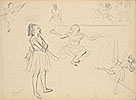 |
 |
Connecting to Centennial
Grades/Level: Lower Elementary (K–2)
Subjects: Visual Arts, English—Language Arts
Lesson Overview: Using a "Thirty-Second Look" activity, students will look closely at and describe the painting A Centennial of Independence. The students will read their ideas and note line, shape, and other details. Then students will create a favorite outdoor memory inspired by the painting, using crayons and the elements of art to guide their work. They will also make connections to the theme of "teamwork."
|
 |
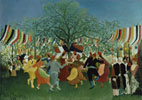 |
 |
I Am a Hard Worker
Grades/Level: Upper Elementary (3–5)
Subjects: Visual Arts, English—Language Arts
Lesson Overview: Students will analyze Man with a Hoe by Jean-François Millet, and learn how the artist's use of shape and space creates emphasis. Students will discuss their interpretations of the painting and provide visual evidence to back up their ideas. They will create a persona poem that demonstrates their interpretation of how the man in the painting feels. Students will then illustrate their understanding of how shape and space creates emphasis by drawing a person in their family who works hard.
|
 |
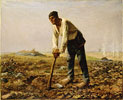 |
 |
Still Life Photography: Daily Life
Grades/Level: Upper Elementary (3–5)
Subjects: Visual Arts, English—Language Arts
Lesson Overview: Students will plan and design a still life composition. When composing the still life, students will choose objects that emphasize a variety of shapes and textures, and arrange the objects to reflect balance. Next students will create a photographic still life and use it as inspiration to write a poem. Then students will present the still life photograph and poem to the class.
|
 |
 |
 |
Fantastical Beasts
Grades/Level: Upper Elementary (3–5)
Subjects: Visual Arts, English—Language Arts
Lesson Overview: Students will learn about medieval manuscripts and artistic representations of fantastical creatures. They will create their own fantastical creature using complementary colors and write a paragraph describing it.
|
 |
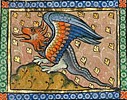 |
 |
Pretty Ugly? The Grotesque in Art and Poetry
Grades/Level: Lower Elementary (K–2)
Subjects: Visual Arts, English—Language Arts
Lesson Overview: Students will discuss works of art that have grotesque elements and symmetry in their design. They will identify symmetry and line in grotesques. Students will create symmetrical designs for a pilgrim bottle and also design a door panel using grotesques. They will then analyze William Blake's poem "The Tiger" and write their own grotesque-inspired poetry.
|
 |
 |
 |
How to Draw a Still Life
Grades/Level: Upper Elementary (3–5)
Subjects: Visual Arts, English—Language Arts
Lesson Overview: Students will form two groups, and each group will analyze a still life. Then each student will write a three-paragraph essay describing how to draw the work of art they are studying. Each student will exchange his or her essay with someone in the other group who will draw the still life based on the essay's description. Depending on the accuracy of their peers' drawings, students will add more details to their essays.
|
 |
 |
 |
The Ultimate Desk
Grades/Level: Upper Elementary (3–5)
Subjects: Visual Arts, English—Language Arts
Lesson Overview: This series of lessons will provide students with an understanding of the Baroque period and help them identify decorative arts and architecture from that period. After studying Baroque paintings, furniture, architecture, and craft guilds, students will create a mixed-media sculpture inspired by Bernard van Risenburgh's Double Desk. Throughout the unit, students will reflect on their experiences in journals.
|
 |
 |
 |
 |
 |
 |
Lessons 1–10 of 41 |
 |
 |
 |
 |
 |

  |
 |









